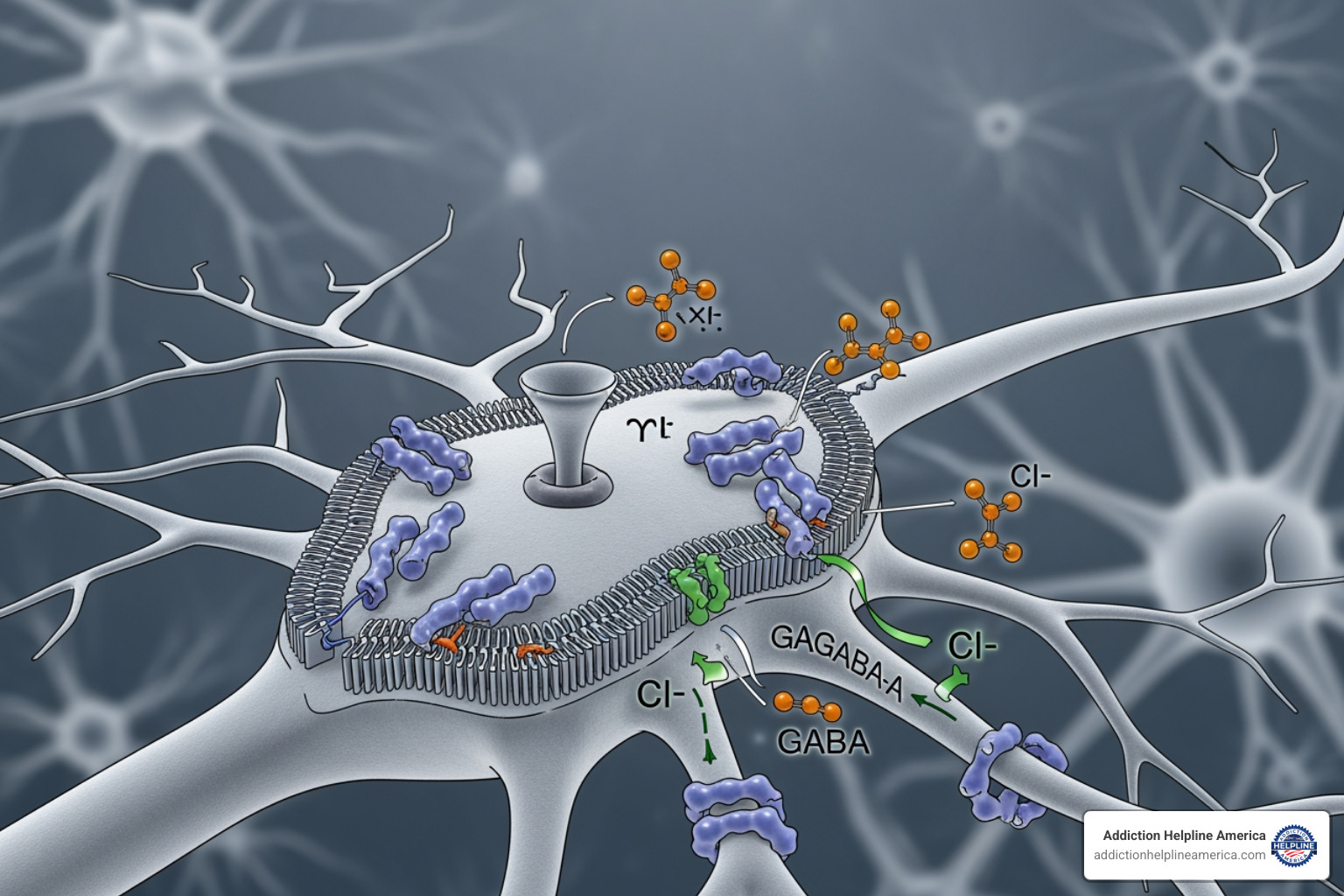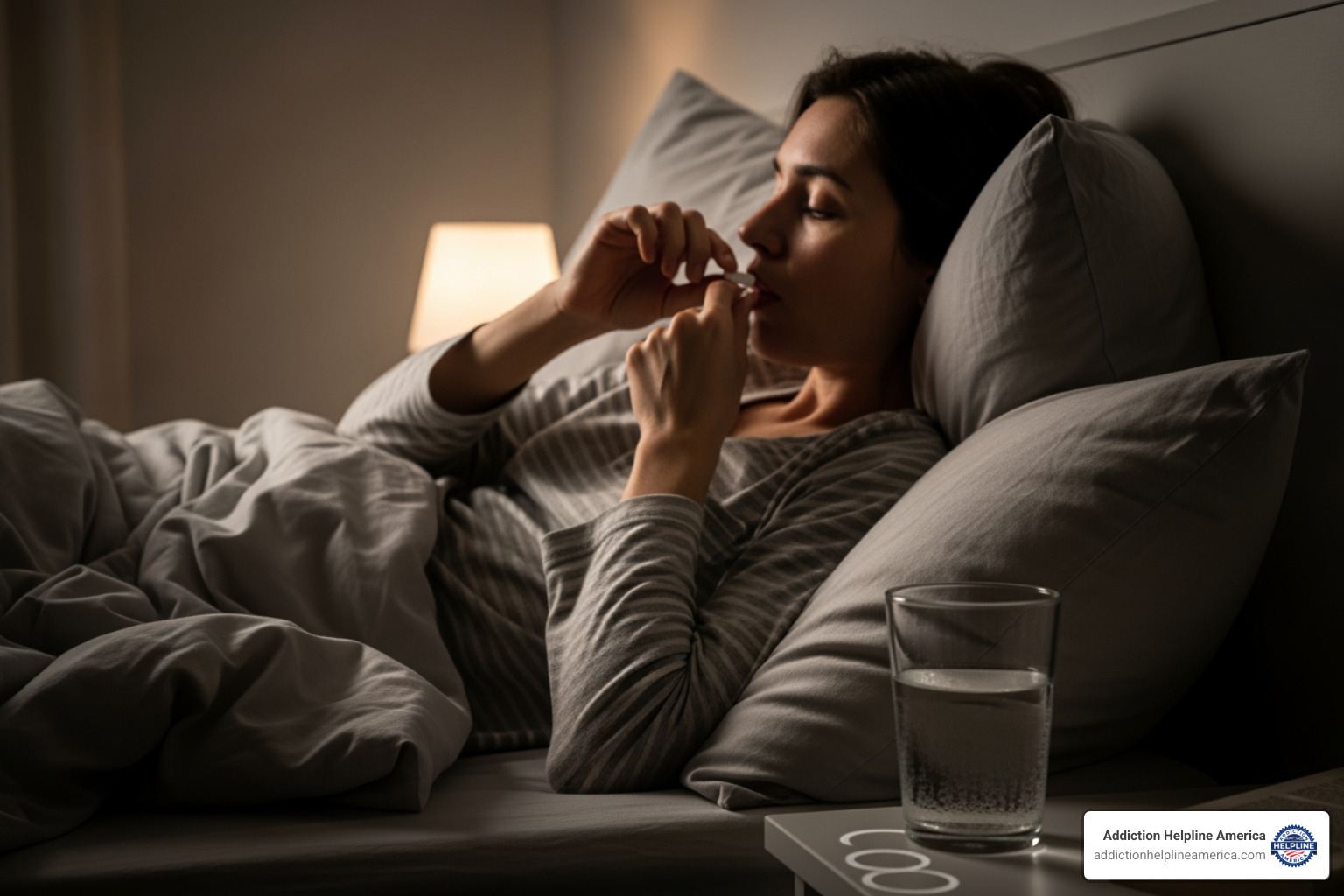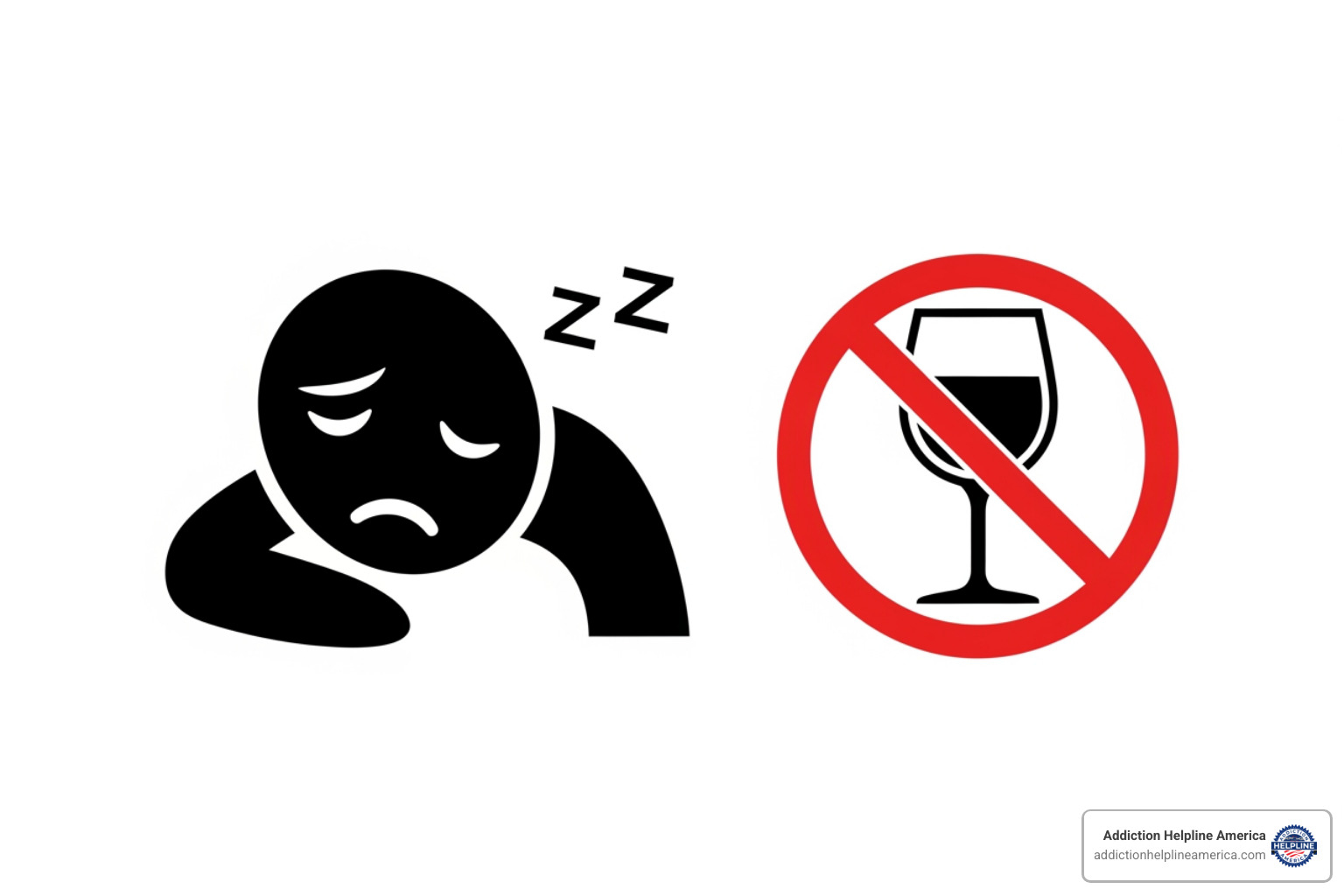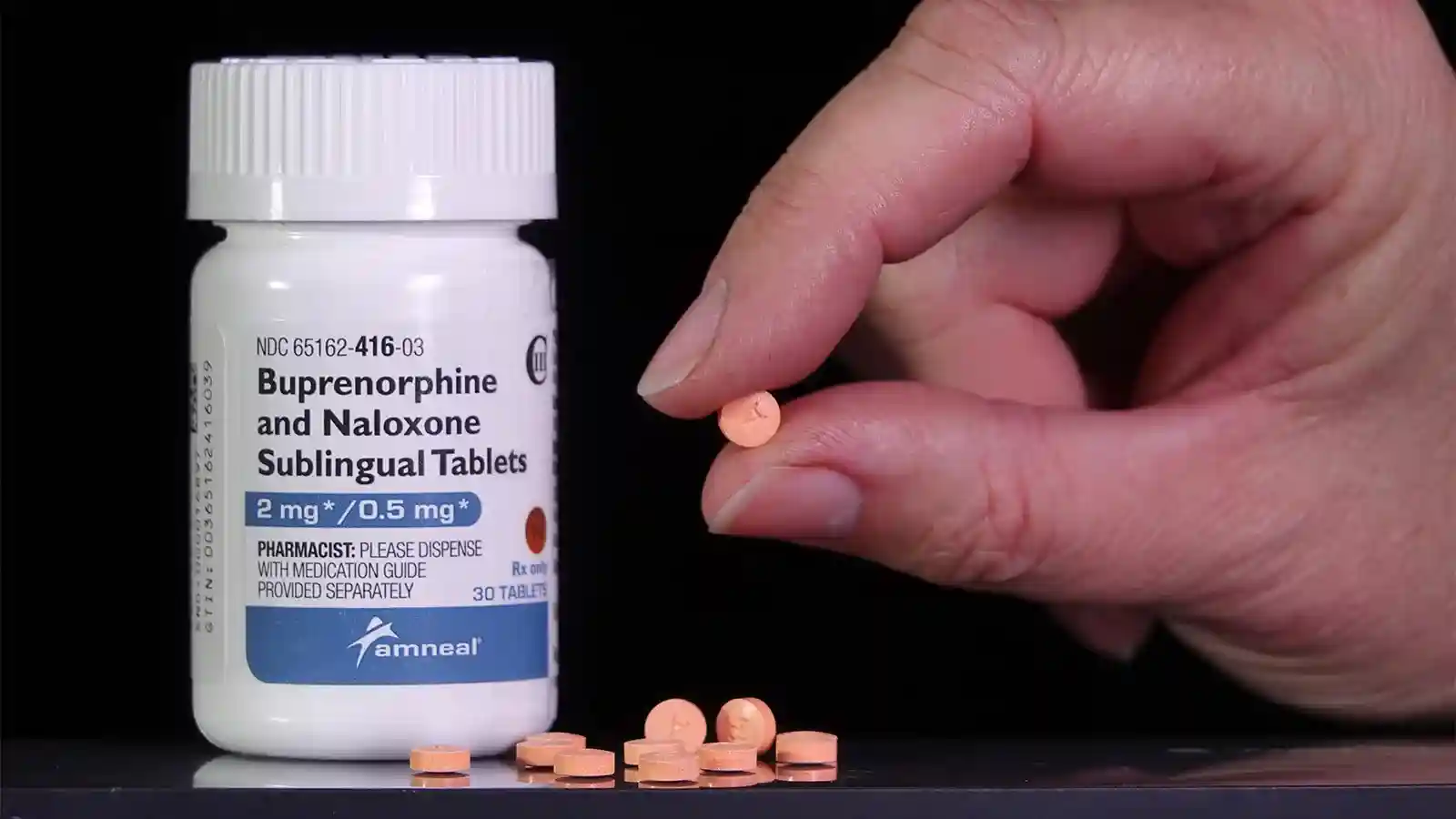
Understanding Zolpidem Tartrate: A Critical Sleep Medication
Zolpidem tartrate is a prescription sedative-hypnotic medication primarily used for the short-term treatment of insomnia. If you’re searching for information about this drug, here’s what you need to know:
Quick Facts About Zolpidem Tartrate:
- What it is: A non-benzodiazepine “Z-drug” that helps people fall asleep faster
- How it works: Slows brain activity by acting on GABA receptors
- Common brand names: Ambien, Ambien CR, Edluar, Zolpimist, Intermezzo
- Available strengths: 5mg and 10mg tablets
- Typical duration: Prescribed for 2 days to 4 weeks only
- Legal status: Schedule IV controlled substance (potential for abuse)
- Usage: In 2023, it was the 54th most commonly prescribed medication in the United States, with more than 11 million prescriptions
While zolpidem tartrate can be effective for treating sleep problems, it carries serious risks. These include next-day drowsiness, memory problems, complex sleep behaviors (like sleep-driving), and potential for dependence. Women and elderly patients face higher risks due to how their bodies process the medication.
This guide will help you understand everything about zolpidem tartrate—from how it works to its dangers, side effects, and safer alternatives. Whether you’re considering this medication or concerned about someone using it, you’ll find clear, evidence-based information here.
At Addiction Helpline America, we’ve helped countless individuals and families steer the complex challenges of prescription medication dependence, including issues related to zolpidem tartrate misuse. Our team understands that even medications prescribed by doctors can lead to serious problems when used long-term or improperly.

What is Zolpidem Tartrate and How Does It Work?
Zolpidem tartrate is a prescription medication in a class of drugs called nonbenzodiazepine hypnotics, or “Z-drugs.” It is primarily used for the short-term treatment of insomnia, helping people fall asleep and stay asleep.
The medication works by enhancing the effects of GABA (gamma-aminobutyric acid), the brain’s natural calming neurotransmitter. It selectively targets specific GABA-A receptors, which slows brain activity to produce sedation. This action reduces the time it takes to fall asleep (sleep latency) and helps maintain sleep. Unlike some older sleep aids, zolpidem generally preserves the natural stages of sleep.
Due to its effectiveness and power, it also has the potential for misuse and dependence. The U.S. government classifies zolpidem tartrate as a Schedule IV controlled substance, meaning its prescription and use are closely monitored. For comprehensive information, refer to the Zolpidem drug information from MedlinePlus.

Brand Names and Formulations
You may know zolpidem tartrate by its brand names. Each formulation is designed for specific sleep issues:
- Ambien: The most common brand, an immediate-release tablet that helps you fall asleep.
- Ambien CR: A controlled-release tablet with two layers. One dissolves quickly to help you fall asleep, while the second releases slowly to help you stay asleep.
- Edluar: A sublingual tablet that dissolves under the tongue for fast absorption.
- Zolpimist: An oral spray that is also absorbed quickly.
- Intermezzo: A low-dose sublingual tablet for middle-of-the-night awakenings, to be taken only if you have at least four hours of sleep time remaining.
Your doctor will choose the right formulation based on whether you have trouble falling asleep, staying asleep, or both. While helpful for short-term insomnia, this drug overrides natural sleep mechanisms and requires careful medical supervision. At Addiction Helpline America, we know that long-term or improper use can lead to serious problems.
Proper Use, Dosage, and Administration
Using zolpidem tartrate correctly is crucial for safety and effectiveness. Because it works quickly (usually within 30 minutes), you should take it only when you are in bed and ready for sleep. For the fastest effect, take it on an empty stomach.
Swallow standard tablets whole with water; do not crush or chew them. The most important rule is to only take zolpidem tartrate if you have a full 7 to 8 hours available for sleep. Taking it without enough sleep time can cause dangerous next-day impairment.
This medication is intended for short-term use, typically 2 to 4 weeks, to avoid the risks of tolerance and dependence. Store it securely at room temperature, away from children. Dispose of any unused medication through a medicine take-back program.

Recommended Dosages for Zolpidem Tartrate
Dosage depends on several factors. The standard strengths are 5mg and 10mg.
- For women: The recommended starting dose is 5mg. Women metabolize the drug more slowly, increasing the risk of morning impairment.
- For men: The typical dose is 10mg.
- For elderly patients (65+) and those with liver/kidney problems: The lower 5mg dose is recommended due to increased sensitivity and risk of side effects like confusion and falls.
- Zolpidem tartrate is not recommended for children.
What to Do If You Miss a Dose
Since this medication is taken as needed, if you forget to take it at bedtime, simply skip the dose. Never take it in the middle of the night unless you still have 7-8 hours to sleep (as with Intermezzo). Never double your dose.
Improper use, such as taking it at the wrong time, can lead to dangerous situations like driving with no memory of the event. If you find yourself struggling to use sleep medication safely or taking it more often than prescribed, please reach out to us at Addiction Helpline America. We are here to help you find safer solutions.
Risks, Side Effects, and Interactions of Zolpidem Tartrate
While effective, zolpidem tartrate carries significant risks and side effects. Common side effects include next-day drowsiness, dizziness, headache, and a ‘drugged’ feeling.
More serious side effects require immediate medical attention:
- Memory loss: You may not remember conversations or activities.
- Mood and behavioral changes: These can include anxiety, confusion, agitation, and, in rare cases, hallucinations, aggression, or suicidal thoughts.
- Severe allergic reactions: Symptoms like hives, swelling of the face or throat, and difficulty breathing are a medical emergency. Call 911.
- Next-day impairment: Your coordination, reaction time, and judgment can be impaired even if you feel awake. This risk is higher for women and led the FDA to recommend lower doses to prevent accidents. Do not drive or operate machinery until you are fully alert.
If you struggle with sedative dependence, our information on Benzodiazepine detox may provide helpful context, as these medications share similar risks.

Complex Sleep Behaviors and Other Dangers
The FDA has issued its most serious ‘boxed warning’ for complex sleep behaviors. These are activities performed while not fully awake, with no memory of them later. They include sleep-driving, sleep-eating, making phone calls, and sleep-walking. These behaviors can result in serious injury or death. If you experience any, stop taking the drug and contact your doctor immediately.
Dangerous interactions can occur with other substances:
- Alcohol: Never mix with zolpidem. The combination dangerously increases sedation and can cause fatal respiratory depression.
- Opioids: This combination is also extremely dangerous and can lead to coma or death.
- Other CNS depressants: Antidepressants, anti-anxiety drugs, and even some antihistamines can amplify sedative effects, increasing the risk of accidents.
Always inform your doctor of all medications and supplements you are taking.
Symptoms and Management of an Overdose
An overdose is a medical emergency. Symptoms progress from extreme drowsiness and confusion to slow/shallow breathing (respiratory depression), loss of consciousness, and coma.
If you suspect an overdose, call 911 immediately. You can also contact poison control at 1-800-222-1222 or visit https://www.poisonhelp.org/help. Hospital treatment involves supporting vital functions. A reversal agent, flumazenil, may be used, but it has its own risks. Seek medical guidance even if you’ve taken too much but feel fine. For urgent advice, resources like the NHS urgent care guidance can be helpful.
Dependence, Long-Term Effects, and Treatment Alternatives
One of the most significant concerns with zolpidem tartrate is its potential for dependence and long-term risks. While it’s designed for short-term use, many people find themselves using it for extended periods, which can lead to serious complications.
- Habit-Forming Potential: Zolpidem tartrate can be habit-forming. Even at recommended dosages, physical dependence can develop within a couple of weeks.
- Tolerance: Over time, your body can develop tolerance, meaning you need higher doses to achieve the same sleep-inducing effect. This can lead to a dangerous cycle of increasing dosage.
- Dependence: This refers to your body’s physiological adaptation to the drug. If you suddenly stop taking it after prolonged use, you can experience withdrawal symptoms. Addiction, on the other hand, involves compulsive drug-seeking behavior despite negative consequences.
- Withdrawal Symptoms: Abruptly stopping zolpidem tartrate, especially after prolonged or high-dose use, can trigger a range of withdrawal symptoms. These can include:
- Rebound insomnia (insomnia that is worse than before you started the medication)
- Anxiety, restlessness, and irritability
- Headaches and muscle pain
- Confusion or agitation
- Tremors
- In severe cases, hallucinations, delirium, and seizures.
Managing these symptoms often requires medical supervision and a gradual tapering schedule. Our page on The Role of Detox in Rehab provides more insight into safely managing withdrawal.
Long-Term Effects and Risks: While research on the very long-term effects of zolpidem tartrate specifically is ongoing, studies on hypnotics in general suggest potential risks with prolonged use. These include:
- Cognitive Decline: Some studies indicate a potential link between long-term hypnotic use and cognitive issues.
- Increased Fall Risk: Especially in elderly patients, prolonged use can increase the risk of dizziness, confusion, and falls, leading to serious injuries.
- Increased Mortality: There’s scientific research suggesting a correlation between long-term hypnotic use and an increased risk of mortality.
- Other Health Concerns: Some meta-analyses have tentatively linked hypnotic use to an increased risk of certain infections, depression, and even some cancers, though these findings often require further investigation and are not definitively proven to be caused by the medication itself. You can find more information on this topic in scientific research on Scientific research on long-term hypnotic use.

Alternatives to Medication for Insomnia
Given the risks associated with zolpidem tartrate, we strongly advocate for exploring non-pharmacological treatments for insomnia first, especially for chronic sleep problems. These approaches address the root causes of insomnia and promote sustainable sleep habits without the side effects or dependence risks of medication.
Here are some effective alternatives:
- Cognitive Behavioral Therapy for Insomnia (CBT-I): This is considered the gold standard treatment for chronic insomnia. CBT-I is a structured program that helps you identify and replace thoughts and behaviors that cause or worsen sleep problems with habits that promote sound sleep. It’s often more effective and has longer-lasting results than medication.
- Good Sleep Hygiene: This involves practicing healthy habits conducive to sleep. Key elements include:
- Maintaining a consistent sleep schedule, even on weekends.
- Creating a comfortable, dark, quiet, and cool sleep environment.
- Avoiding caffeine, nicotine, and alcohol, especially in the afternoon and evening.
- Limiting naps, particularly late in the day.
- Avoiding large meals close to bedtime.
- Relaxation Techniques: Practices that help calm your mind and body can significantly improve sleep. These include:
- Meditation: Mindfulness meditation can reduce stress and improve sleep quality.
- Deep Breathing Exercises: Techniques like diaphragmatic breathing can activate the body’s relaxation response.
- Progressive Muscle Relaxation: Tensing and then relaxing different muscle groups can release physical tension.
- Regular Exercise: Engaging in moderate physical activity during the day can promote better sleep at night. However, avoid intense exercise too close to bedtime, as it can be stimulating.
We believe that a holistic approach, starting with these non-medication strategies, is often the safest and most effective path to lasting sleep improvement.
Frequently Asked Questions about Zolpidem
We understand that when you’re considering a medication like zolpidem tartrate, you probably have questions. Let’s walk through some of the most common concerns we hear from people just like you.
How long does it take for zolpidem to work?
One thing that makes zolpidem tartrate stand out is how quickly it gets to work. Most people feel its effects within about 30 minutes of taking it. That’s why timing matters so much—you’ll want to take your dose immediately before you’re ready to get into bed and fall asleep.
Because it works so fast, we can’t stress enough the importance of planning ahead. Make sure you have a full 7 to 8 hours available for sleep before you need to be up and functioning. Taking zolpidem tartrate and then trying to wake up just a few hours later is a recipe for dangerous drowsiness and impairment.
Can I drink alcohol while taking zolpidem?
This is one question where we need to be crystal clear: No. Absolutely not. We issue a strong warning against mixing alcohol with zolpidem tartrate, and here’s why.
Both alcohol and zolpidem tartrate are central nervous system depressants. When you combine them, you’re essentially doubling down on the sedative effects. This dangerous combination significantly increases your risk of extreme drowsiness, severely impaired coordination, and those frightening complex sleep behaviors we discussed earlier—like sleep-driving or sleep-walking.
Even more concerning, mixing alcohol with zolpidem tartrate heightens your risk of respiratory depression, where your breathing becomes dangerously slow or shallow. This can be life-threatening and may lead to overdose.
For your safety, please avoid alcohol completely while taking this medication. It’s simply not worth the risk.
Is zolpidem safe for elderly patients?
This is an important question, and the answer requires some nuance. Zolpidem tartrate can be prescribed to elderly patients, but it must be used with considerable caution.
Older adults—typically those 65 and over—tend to be much more sensitive to the effects of zolpidem tartrate. Their bodies process the medication more slowly, which means it stays in their system longer. This increased sensitivity brings several concerns: a higher risk of confusion and memory problems, greater likelihood of dizziness and dangerous falls (which can lead to serious injuries like hip fractures), and more pronounced next-day impairment that can affect their ability to safely perform daily activities.
In fact, the American Geriatrics Society has taken a firm stance on this issue. Through their Beers Criteria—which identifies potentially inappropriate medications for older adults—they recommend avoiding zolpidem tartrate altogether in people 65 and over. Their reasoning? The potential harms often outweigh the minimal benefits in this age group.
If your elderly loved one’s doctor does prescribe zolpidem tartrate, it should always be at the lowest possible dose (typically 5mg rather than 10mg) and for the shortest duration necessary. We encourage families to discuss alternative treatments with their healthcare provider, as non-medication approaches may be safer and more effective for older adults struggling with sleep issues.
Conclusion: Making Informed Decisions About Insomnia Treatment
Throughout this guide, we’ve walked through the complexities of zolpidem tartrate—from how it works in your brain to the very real risks it carries. Let’s bring it all together.
Yes, zolpidem tartrate can be effective for short-term insomnia relief. It helps many people fall asleep faster and get the rest they desperately need. But “effective” doesn’t mean “safe for everyone” or “appropriate for long-term use.” As we’ve discussed, this medication comes with significant risks and side effects that shouldn’t be taken lightly.
The dangers we’ve outlined—complex sleep behaviors like sleep-driving, next-day impairment that can affect your ability to drive or work safely, memory problems, and the very real potential for dependence—are not just theoretical. These happen to real people. The high potential for physical and psychological dependence means that what starts as a helpful sleep aid can, over time, become a problem in itself.
This is why medical supervision is absolutely critical. If your doctor prescribes zolpidem tartrate, take it exactly as directed. Stick to the recommended duration of 2 to 4 weeks maximum. Never increase your dose on your own, and never, ever combine it with alcohol or other sedatives. These aren’t just suggestions—they’re essential safety measures.
Here’s something we feel strongly about: if you’re dealing with chronic insomnia, we encourage you to explore non-medical alternatives first. Cognitive Behavioral Therapy for Insomnia (CBT-I) has been shown to be just as effective as medication for many people, often with longer-lasting results and none of the risks. Good sleep hygiene practices, relaxation techniques like meditation or deep breathing, and regular exercise can transform your sleep without introducing the complications that come with medication.
If you or someone you care about is struggling with zolpidem tartrate dependence, please hear this: you’re not alone, and help is available. At Addiction Helpline America, we’ve walked alongside countless individuals and families facing this exact challenge. We provide free, confidential support to connect people nationwide with addiction and mental health treatment centers. Whether you’re in Alabama or Wyoming, California or Connecticut, Florida or Montana—we’re here to help you find the right recovery program from our extensive network across all 50 states and the District of Columbia.
The path to better sleep—and to freedom from dependence—doesn’t have to be walked alone. We can help you find personalized drug addiction treatment options that address your unique situation and needs.
Your health and safety matter. Making informed decisions about insomnia treatment means weighing all the options, understanding the risks, and knowing when to ask for help. We’re here whenever you’re ready.
Our helpline is 100%
free & confidential
If you or someone you care about is struggling with drug or alcohol addiction, we can help you explore your recovery options. Don’t face this challenge alone—seek support from us.
Programs
Resources
Will my insurance
cover addiction
treatment?
We're ready to help
Find the best
drug or alcohol treatment
center
Are you or a loved one struggling with addiction? Call today to speak to a treatment expert.












